Douglas Dolphin
The Douglas Dolphin was an amphibious flying boat. While only 58 were built, they served a wide variety of roles: private 'air yacht', airliner, military transport, and search and rescue.[3]
| Dolphin | |
|---|---|
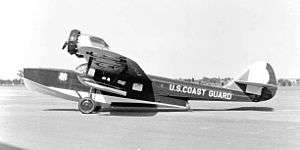 | |
| U.S. Coast Guard RD-2 in June, 1932 | |
| Role | Multirole flying boat |
| Manufacturer | Douglas Aircraft Company |
| First flight | July 1930 (Sinbad) |
| Introduction | 1931 |
| Primary users | United States Navy[1] United States Coast Guard[1] |
| Number built | 58[2] |
Design and development
The Dolphin originated in 1930 as the "Sinbad," a pure flying boat without wheels. The Sinbad was intended as a luxurious flying yacht. Undaunted by the lack of demand, Douglas improved the Sinbad in 1931 so that it was amphibious, and could land on water or land. The improved aircraft was named "Dolphin", however this did not represent the end of development, as many detail improvements were made, including an increase in the length of over a foot and changes made to the empennage, engine nacelles and wings.[4] The Great Depression had curtailed demand for such extravagance as a "flying yacht", but Douglas managed to interest the United States Coast Guard who not only bought the Sinbad, but 12 Dolphins.[5]
Operational history
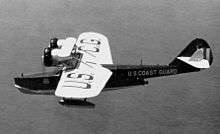
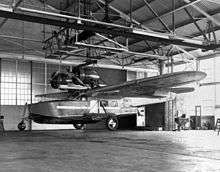
The first two were purchased by Wilmington-Catalina Airlines to fly passengers between Los Angeles and Santa Catalina Island, becoming the first successful Douglas airliners. Subsequent examples were ordered by the United States Navy and U.S. Coast Guard for use as transports and search and rescue craft. The U.S. Army Air Corps ordered several under the designations C-21, C-26, and C-29. Many were eventually ordered for their original purpose as luxury transports. Owners included William Boeing, the founder of the Boeing Company, and Philip K. Wrigley, the son of the founder of the Wm. Wrigley Jr. Company. William K. Vanderbilt bought two with custom interiors for use from the Vanderbilt yacht Alva as flying tenders.[6][7]
One was procured by the U.S. Navy as a transport for President Franklin D. Roosevelt.[8] Although never used by Roosevelt, this was the first aircraft procured to provide transportation for the President of the United States.[9]
In 1933, landing in heavy seas, the USCG RD-4 undertook some rescues of merchant sailors at sea, feats that made spectacular news reports, enthralling the American public.[10]
Variants
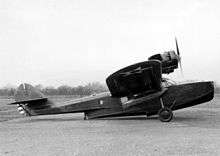
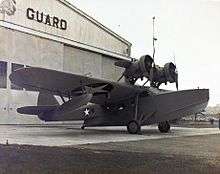
Data from:McDonnell Douglas Aircraft since 1920 Vol.1[1]
- Douglas Sinbad
- The original prototype built as a flying boat, intended to be a luxurious flying yacht, first flown in July 1930. No orders were received for the Sinbad which was eventually bought by the U.S. Coast Guard.
- Dolphin Model 1
- The initial two Dolphins built for the Wilmington-Catalina Airline Ltd. as six-seat airliners.
- Dolphin Model 1 Special
- The Model 1s redesignated after modification to seat eight passengers.
- Dolphin Model 3
- The third commercial Dolphin built as a luxury transport named Lesgo with seats for two crew and four passengers for Powel Crosley Jr., powered by 2x 300 hp (224 kW) Pratt & Whitney Wasp Junior A engines. Later impressed into the RAAF as A35-3.
- Dolphin 113
- One aircraft named Jade Blanc V for French clothing manufacturer Armand Esders (who also owned a Bugatti Royale) similar to the RD-4, powered by 2x 550 hp (410 kW) Pratt & Whitney R-1340-S1H1 Wasp engines.
- Dolphin 114
- A single Dolphin built to order for Philip K. Wrigley, powered by 2x 450 hp (336 kW) Pratt & Whitney Wasp SC1 engines.
- Dolphin 116
- One aircraft for the Armada Argentina (Argentine Navy), powered by 2x 450 hp (336 kW) P&W R-1340-96.
- Dolphin 117
- One aircraft initially named Rover, bought by William E. Boeing, which ended up in CAA (forerunner of the current Federal Aviation Administration) service. Sole surviving example, painted in USCG markings.
- Dolphin 119
- Two aircraft built for Alfred Gwynne Vanderbilt Jr. and William Kissam Vanderbilt II and operated from the yacht Alva. One of the two (which is unknown) joined the RAAF as A35-2.
- Dolphin 129
- Two aircraft ordered by Pan American Airways for its subsidiary (at that time) China National Aviation Corporation, powered by 2x 450 hp (336 kW) Pratt & Whitney Wasp S3D1 engines. One crashed in heavy seas and the other was destroyed during or shortly after the Japanese invasion of China.
- Dolphin 136
- A single Dolphin, powered by 2x 450 hp (336 kW) Pratt & Whitney Wasp Junior SB engines, ordered by Standard Oil and later impressed by the RAAF as A35-1.
- FP-1
- Several C-21 aircraft loaned to the U.S. Treasury Department for border patrols during Prohibition.
- FP-2
- The two Y1C-26 Dolphins during a brief attachment to the U.S. Treasury Department.
- FP-2A
- The designation used by those Y1C-26A aircraft that were attached to the U.S. Treasury Department.
- FP-2B
- The two C-29s when in use by the U.S. Treasury Department.
- RD-1
- One aircraft, powered by 2x 435 hp (324 kW) Wright R-975E radial engines, operated by the U.S. Navy.
- RD-2
- Four Dolphin aircraft of two distinct types. One Aircraft similar to the Y1C-21 and powered by 2x 500 hp (373 kW) Pratt & Whitney R-1340-10 engines, for the U.S. Coast Guard. Two were U.S. Navy VIP staff transports similar to the Y1C-26 powered by 2x 450 hp (336 kW) Pratt & Whitney R-1340-96 engines. The final aircraft was completed for the U.S. Navy as the first presidential aircraft, for Franklin D. Roosevelt, powered initially by 2x 410 hp (306 kW) Pratt & Whitney R-1340-1 engines and later by 2x 500 hp (373 kW) Pratt & Whitney R-1340-10 engines, seating five though it was reportedly never used by the President.
- RD-3
- A utility transport version of the RD-2, six of which were built for the U.S. Navy, powered by 2x 500 hp (373 kW) Pratt & Whitney R-1340-4 or by 2x 500 hp (373 kW) Pratt & Whitney R-1340-96 engines.
- RD-4
- Ten aircraft for the U.S. Coast Guard, powered by 2x 420 hp (313 kW) Pratt & Whitney Wasp C1 engines.
- OA-3
- C-21 aircraft redesignated.
- OA-4
- C-26 aircraft redesignated.
- OA-4A
- Y1C-26A aircraft redesignated.
- OA-4B
- C-26B aircraft redesignated, one of which was fitted with an experimental fixed tricycle undercarriage.
- OA-4C
- Four OA-4A and one OA-4B aircraft modernized in 1936.
- Y1C-21
- Eight aircraft for the USAAS, similar to the Navy's RD-1, powered by 2x 350 hp (261 kW) Wright R-975-3 engines.
- Y1C-26
- Two aircraft for the USAAS with increased dimensions, fin area and fuel capacity (from180 US gal (681 l) to 240 US gal (908 l)). Powered by 2x 300 hp (224 kW) Pratt & Whitney R-985-1 engines.
- Y1C-26A
- Eight aircraft for the USAAS differing from the Y1C-26 only in minor details.
- C-21
- Y1C-21 aircraft redesignated.
- C-26
- Y1C-26 aircraft redesignated.
- C-26A
- Y1C-26A aircraft redesignated.
- C-26B
- Four aircraft powered by 2x 400 hp (298 kW) Pratt & Whitney R-985-9 engines.
- C-29
- Two Dolphins, powered by 2x 550 hp (410 kW) Pratt & Whitney R-1340-29 engines, were essentially similar to the Y1C-26As.
Military operators

- U.S. Army Air Corps
- U.S. Army Air Force
- United States Coast Guard
- U.S. Marine Corps
- United States Navy
Specifications (RD-3 Dolphin)
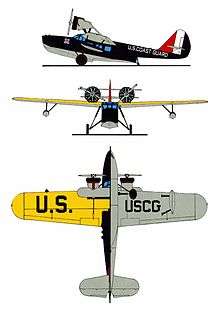
Data from McDonnell Douglas Aircraft since 1920, Vol. 1[11]
General characteristics
- Crew: Two, pilot and co-pilot
- Capacity: Six passengers
- Length: 45 ft 3 in (13.79 m)
- Wingspan: 60 ft (18 m)
- Height: 15 ft 2 in (4.62 m)
- Wing area: 637 sq ft (59.2 m2)
- Empty weight: 6,764 lb (3,068 kg)
- Gross weight: 9,734 lb (4,415 kg)
- Fuel capacity: 240 US gal (908 l)
- Powerplant: 2 × Pratt & Whitney R-1340-4 Wasp 9-cyl. air-cooled radial piston engines, 450 hp (340 kW) each
- or 2x 450 hp (336 kW) Pratt & Whitney R-1340-96 Wasp engines
Performance
- Maximum speed: 149 mph (240 km/h, 129 kn) at sea level
- Cruise speed: 105 mph (169 km/h, 91 kn)
- Range: 692 mi (1,114 km, 601 nmi)
- Service ceiling: 15,100 ft (4,600 m)
- Rate of climb: 806.5 ft/min (4.097 m/s)
- Time to altitude: 5,000 ft (1,524 m) in 6 minutes, 12 seconds
- Wing loading: 16.4 lb/sq ft (80 kg/m2)
- Power/mass: 0.093 hp/lb (0.204 kW/kg)
See also
Aircraft of comparable role, configuration and era
- General Aviation PJ
- Hopfner HA-11/33
- Saro Cloud
- Saro Cutty Sark
- Grumman Goose
Related lists
References
Notes
- Francillon 1988, pp. 102–103.
- Francillon 1988, p. 103.
- Francillon 1988, p. 102.
- Francillon 1988, p. 104.
- Rumerman, Judy. "Douglas Aircraft Builds the DC-1 and DC-2." Archived September 19, 2002, at the Wayback Machine Centennial of Flight, 2003. Retrieved: March 5, 2012.
- Francillon 1988, pp. 105–107.
- Bowers 1982, pp. 11–25.
- Bowers 1982, pp. 49-50.
- "Mayflower of the Air ready for President." Popular Science, May 1933, p. 713. Retrieved: March 5, 2012.
- "Flying Life Savers." Popular Mechanics Monthly, December 1933, pp. 900–903.
- Francillon 1988, pp. 110–111.
Bibliography
- Bowers, Peter M. "Douglas Dolphin." Airpower, Volume 12, Number 6, November 1982.
- Francillon, René J. McDonnell Douglas Aircraft since 1920, Volume 1. London: Putnam & Company Ltd., Second revised edition, 1988, 1979. ISBN 0-85177-827-5.
External links
![]()